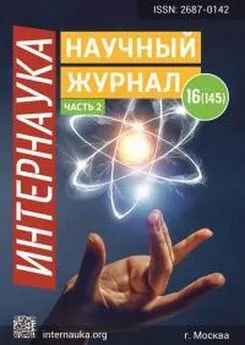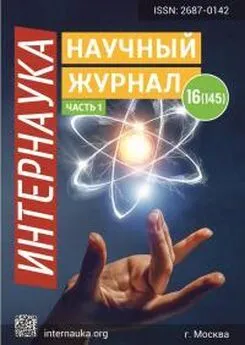Интернаука - Интернаука №16 (часть3) 2020
- Название:Интернаука №16 (часть3) 2020
- Автор:
- Жанр:
- Издательство:COMPANY BY ANA4220
- Год:2020
- ISBN:2687-0142
- Рейтинг:
- Избранное:Добавить в избранное
-
Отзывы:
-
Ваша оценка:
Интернаука - Интернаука №16 (часть3) 2020 краткое содержание
Интернаука №16 (часть3) 2020 - читать онлайн бесплатно полную версию (весь текст целиком)
Интервал:
Закладка:
"Where there is a will, there is a way." Students prove lesson so that students can join the work as soon as pos-the veracity of the proverb. The result is this: He is sible, at any convenient and appropriate stage of the sometimes lazy. He can’t write English words. He
lesson. Teacher suggests situations based on interests of
doesn’t study them. The teacher is unhappy. But today
this age of students, their life experience. For example:
he is clever. He has got a “5”. He knows all the words.
One of the guys has a birthday soon. The guys usually Everyone is happy. “Where there is a will, there is a talk about it beforehand. Teacher suggests the situation:
way.”
He is happy, he is celebrating his birthday. It is his The culture of communication also includes written
9th birthday. I am sure he likes this day. Do you want to
speech. The main purpose of writing is communication.
know, why? Students are encouraged to ask questions
Writing is divided into two types: formal and informal.
about what they do (usually) on their birthday. The
The formal writing consists of a letter of complaint, a teacher can prompt an indirect question about what to letter requesting, an application letter, an invitation and
42
Журнал «Интернаука»
№ 16 (145), часть 3, 2020 г.
an essay. Informal writing consists of making notes,
I hope you and your family are well. …………you
shopping lists and others. In writing pupils cannot ex-for your letter. I like reading about your family. It’s half press their impressions with gestures, mimes and tone of
–term and we’ve got one week of holiday. It’s ………! I
voice. In order to that they need to use suitable phrases
like half term because I do all the things I like. For ex-
and words. For this schoolchildren have a plenty of
ample, I go to the park. There is a playground and my words in their lexical base. We can see writing letter
………. John likes playing football. I like playing com-
activities between Anvar and Lucy in English Fly High
puter games and collecting coins. I’ve got a collection Pupils’ book. Handout1. Pupils read the full form of the
of coins from a lot of countries: America, India, Aus-letter silently and attentively.
tralia, Russia and …………….. What about you? What
DearAnvar,
do you like doing? Have you got a hobby? Please write
I hope you and your family are well. Thank you for
and tell me. There are two things I don’t like. I don’t your letter. I like reading about your family. It’s half –
like tidying up my room and cooking!
term and we’ve got one week of holiday. It’s great! I
………..Lucy
like half term because I do all the things I like. For ex-
The pupils can find the missing words easily. The
ample, I go to the park. There is a playground and my pupils fill in the gaps with great interest. I think this brother John likes playing football. I like playing com-activity is more useful to develop their writing commu-
puter games and collecting coins. I’ve got a collection nication culture.
of coins from a lot of countries: America, India, Aus-Non-verbal communication is familiar as a Body
tralia, Russia and Uzbekistan. What about you? What do
language. English people are less talkative naturally and
you like doing? Have you got a hobby? Please write and
like to speak with gesture. In foreign language lessons tell me. There are two things I don’t like. I don’t like Body language is more effective way to explain unfa-tidying up my room and cooking!
miliar or new words and phrases, especially for young LoveLucy
learners. They are keen on playing “miming game” ac-
Handout 2. Fill in the gaps. (the missing words are
tivity. I give some examples of body language expres-common and simple)
sions which are used in the classroom.
…….Anvar,
Table 1.
Non- verbal behavior
Non- verbal behavior
Interpretation
Sitting, legs apart
Open, relaxed
Arms crossed on chest
Defensiveness
Touching, slightly rubbing nose
Doubt or lying
Head resting in head, eyes down
Boredom
Open palm
Confidence
Fondling hair
Sincerity, openness
Looking down and away
disbelief
Teaching a combination of verbal and non-verbal
language learning process in general and on the stu-
aspects of communication has positive effects on the
dents’ willingness to communicate in particular.
References:
1. Language Art and Disciplines. 1980. E.M.Vereshchagin.
2. I. Yuldashev, O. Sharipova “Tilshunoslik asoslari” 2007
3. A.Abdulazizov “Tilshunoslik nazariyasiga kirish” 2018
4. Методика обучения иностранным языкам в средней школе. Рогова. Р.В
5. Электронный ресурс: www.e-library.namdu.uz
6. Электронный ресурс: www.brainyquote.com
43
Журнал «Интернаука»
№ 16 (145), часть 3, 2020 г.
COMPARISON OF ENGLISH-LANGUAGE SCIENTIFIC DISCOURSE AND RUSSIAN-LANGUAGE SCIENTIFIC DISCOURSE
Aigerim Mukanova
Master student, Karaganda State University named after E.A. Buketova, Kazakhstan, Karaganda
ABSTRACT
The article discusses the process of formation of Russian scientific discourse taking place in the Moscow state in the second half of the XVII century. The key aspects of this process are analyzed, which include the approval of the analytical type of grammatical description, the formation of a modern term system by traditional translation techniques to new types of texts. Comparison of Russian-language and English-language scientific discourse.
Keywords:scientific discourse, text, language, term, communication.
Scientific discourse is a process of creating new
is so compact that an expert reader can quickly publish
knowledge about a subject, phenomenon, their proper-
an article and get important information” [2].
ties and qualities, presented orally and defined by the Linguist I. Martinez, in turn, draws attention to the
communicative canons of scientific communication -
widespread use of impersonal constructions in academic
logical presentation, proof of the correctness and incor-
texts that “allow authors to strategically distance them-
rectness of certain provisions, the ultimate abstraction of
selves from the information they write about” [3]. Thus,
the subject of speech. We know the scientific text as a it denotes an important feature of scientific syntax in the
subject-symbolic model of discourse. Given the above,
English language tradition.
the text act as the main unit of discourse, and so we can
Basically the functional features of the English lan-
conclude that the properties of the text as a model of guage scientific discourse and language means of ex-discourse can be extended to the discourse itself. The pressing logical connections can be brought to the fol-text is a model of discourse, and its properties as parts lowing characteristics:
are transferred to the whole and vice versa. Therefore, 1) language compression (compression of a cer-considering the text, we also study the discourse, in tain material):
turn, the study of discourse without reference to the text
use of attribute phrases (quality improvement,
will not be possible.
productivity increase, etc.);
The scientific type of discourse, on the other hand,
replacement with infinitive constructions or
which is part of the scientific system, is a difficult cog-
subordinate clauses (energy, companies supplying etc.);
nitive structure based on the relationship reflected in the
use of phrases with prepositions (the first step in
language between our view of the world and the repre-
finding solutions, etc.);
sentation of this view in the language, and therefore is a
use of application phrases (In four cohorts, sci-
constituent element of the general system. Also, the
entists stated that…, etc.).
scientific type possesses a number of its own constitu-2) formality: use of formal or neutral vocabulary
tive, system-forming features that distinguish it from (discuss vs. talk about, have a look at vs. examine, etc)
other types of discourse.
[4];
Since the beginning of the 21st century, English has
use of formal grammar (impersonal: there / it as
advanced to the role of a universal intermediary lan-a subject);
guage - linguafrank - in politics, economics, education,
use of indefinite constructions instead of affirm-
and in global scientific discourse. To strengthen the ative ones (modal verbs: may /might; verbs: seem to /
position of the English language as the main means of appear; adverbs: possibly / probably; etc.);
information exchange in the modern world, as well as in
use of the passive voice as impersonal construc-
the scientific field, several factors work - political, cul-tions (some facts should be imposed..., etc.).
tural, economic, etc.
3) rating (tendency to more use of nouns in compar-
The functional specifics of the English-language
ison with the verbal parts of speech);
scientific discourse are effectively studied in the works 4) connectivity (lexical and grammatical relation-of many Russian and foreign linguists. Thus, E.
ships) [5]:
Koyalan and S. Mumford in their works emphasize that
reference (pronouns replacing or pointing to
writing academic articles in English for non-native
other words or parts of the text);
speakers of this language culture can be particularly
ellipsis (omission of a word or phrase under-
difficult due to serious differences in the traditions of stood from the context);
scientific thought design[1].
D. Bieber and B. Gray, who are also involved in the
Substitution (replacing a word or an entire
development of this problem, refute complex stereo-
phrase with a language unit similar in meaning);
types and the prevalence of structures in the RussianUnion connection (unions serve not only to con-
language scientific discourse and emphasize the preva-
nect the relative clause with the main, but also indicate
lence of concise structures, for example, phrases with a
the type of connection);
nominative structure. They believe that “scientific prose
lexical coherence (the use of synonyms and words
that are close in meaning, as well as generalization and
concretization);
44
Журнал «Интернаука»
№ 16 (145), часть 3, 2020 г.
objectivity (impersonal manner of presentation
and the scientific style at the scientific level of generali-of the material);
zation. At the same time, the style of scientific discourse
hedging (mitigation of the response, hidden ex-
is meaningfully aimed at identifying the semantic struc-
pression of the author’s opinion) through:
ture of the multidimensional space of scientific speech,
• modal verbs expressing probability, resolution,
determining units of analysis of the semantic structure ability (can, might), necessity, obligation (had better, of a scientific text, and also analyzing the language of have to, ought to), prediction, will (would, shall);
Читать дальшеИнтервал:
Закладка:


